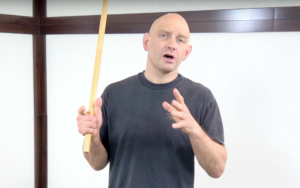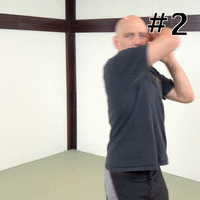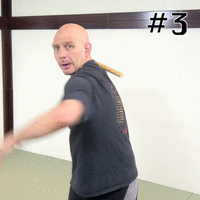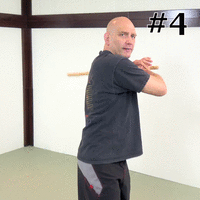OK, you’re walking down the street and three guys jump out at you…
You have to fight; you can’t run, but there is a stick close to your feet.
Do you A) ignore the stick and defend yourself with the third technique from the second kata, or B) you pick up the stick and start swinging for the fences?
In 99% of cases the right answer the answer is B – use the bloody stick!
Even if you don’t actually have to hit anyone, them knowing that you’re now armed and seem comfortable waving your weapon around could give them major pause, possibly even ending the fight without fighting!
So if you’re interested in self defense then a basic understanding of handling weapons is really important. And generally you want to acquire the high percentage, easy-to-learn stuff first!
When it comes to sticks and other blunt weapons the name of the game is POWER! The harder you hit someone with a stick, the greater the effect.
With sharp or pointed weapons even a light cut can have dire consequences, so speed and precision are probably the most important attributes.
Since power is important, it’s legitimate to ask what the most powerful strikes are that you can deliver with a stick!
With sharp or pointed weapons even a light cut can have dire consequences, so speed and precision are probably the most important attributes.
But when it comes to sticks, clubs, and other blunt tools then the ability to develop power becomes very important. The harder you hit someone with a stick, the greater the effect.
So it’s legitimate to ask what the most powerful strikes are that you can deliver with a stick!
Maybe you’ve heard of the numbering systems that’s used in the Filipino Martial Arts (FMA)?
Most (but not all) styles of FMA have a ‘numbering system’ for their strikes, with each number designating an angle and (sometimes) a target. These strikes would be roughly the same regardless if you were using a stick, knife, sword, fist, whip chain or three sectional strike: a number 1 angle is a number 1 angle, regardless of what what you’ve got in your hand.
Most often there are systems with 12 numbered strikes, although I’ve also seen systems with 5, 8, and 64 attacks numerically differentiated.
Here’s the interesting thing though…
The most powerful strikes with a stick are also usually the first few angles in most FMA numbering systems. This makes sense, because you want to teach your fighters the most powerful, highest percentage shots first, right?
So let’s go over angles 1 to 5, which, as I just mentioned, are also the big power shots!
Powershot 1
The angle 1 strike is a forehand that cuts down at roughly 45 degrees (although some systems bring it down a little closer to vertical).
This is the most used and most instinctive strike; a chimpanzee with a stick will use this angle on another chimp, and a highly trained full contact stick fighter will use it against his highly skilled opponents. It’s the ‘right cross’ of the stick fighting world.
Powershot 2
The angle 2 strike is a backhand that also cuts down at roughly 45 degrees, just in the opposite way from the number 1. And yes, some systems bring it down a little closer to vertical.
This is a bit less instinctive than the number 1, but still very powerful. First of all, you do have gravity on your side, accelerating both your arm and the weapon. Additionally you can also brace and push off with your free hand against the forearm of the weapon arm, which gives you an added boost of speed and power.
Powershot 3
The angle 3 strike is a forehand strike that cuts across horizontally. Think of how you swing a baseball bat and you’ve got the idea.
The height of the strike depends a little bit… Some systems send it across at elbow level, whereas other prefer to aim for the middle of the head (the ear). The power generation mechanics stay pretty much the same no matter what the targeting is.
Powershot 4
The angle 3 strike is another horizontal strike, this time a backhand. Think Rafael Nadal with a killer backhand hit in tennis.
This angle is a legitimate strike in it’s own right, but can also be used to ‘clear the decks’ if someone is pressing you too hard. It’s the ultimate way to tell someone that you need more space!
Powershot 5
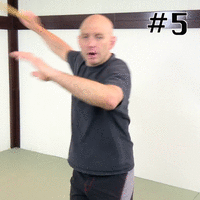
Number 5 in most systems is a thrust of some sort. When it comes to power shots, though, the thrust is delivered with windup and momentum; leave the delicate arm-only thrusting to épée fencers with their very-sharp swords.
Typically this style of number 5 will be delivered in combination with other strikes, as a followup to an already off balanced opponent, or in conjunction with the clinch. But all that power concentrated onto the little tiny tip of a stick can make for a very high-psi strike!
Power Generation and More…
Here’s a video I shot for the Self Defense Tutorials Youtube channel which breaks down these 5 strikes even further.
One important topic covered in the video are more details about power generation (hint: it’s mostly how you use your body, not move your arm).
Anyway, check it out right here:
If you find this sort of article or video useful then consider signing up for my Self Defense newsletter below.
In it I give you some of my best martial arts tips, tricks and training methods. It’s similar-but-different to the acclaimed BJJ email newsletter that I send out on my other site, Grapplearts.com
I would suggest signing up, checking it out and – if you don’t like it for any reason – then unsubscribing easily by following the ‘manage your subscription’ link at the bottom of any email I’ll ever sent you.
But I promise you, you’ll get good stuff!
Get My FREE Self Defense Tips by Email
